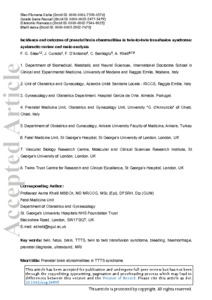Sileo, FG; Curado, J; D'Antonio, F; Benlioglu, C; Khalil, A
(2022)
Incidence and outcome of prenatal brain abnormality in twin-to-twin transfusion syndrome: systematic review and meta-analysis.
Ultrasound Obstet Gynecol, 60 (2).
pp. 176-184.
ISSN 1469-0705
https://doi.org/10.1002/uog.24895
SGUL Authors: Khalil, Asma
![[img]](https://openaccess.sgul.ac.uk/114323/1.hassmallThumbnailVersion/Ultrasound%20in%20Obstet%20Gyne%20-%202022%20-%20Sileo%20-%20Incidence%20and%20outcome%20of%20prenatal%20brain%20abnormalities%20in%20twin%20to%20twin.pdf)  Preview |
|
PDF
Accepted Version
Available under License ["licenses_description_publisher" not defined].
Download (700kB)
| Preview
|
Abstract
OBJECTIVES: to ascertain the incidence of antenatally diagnosed brain injuries in twin pregnancies complicated by twin to twin transfusion syndrome (TTTS) and to quantify the perinatal mortality, morbidity and long-term neurodevelopmental outcomes of these fetuses. METHODS: Medline, Embase, Clinicaltrials.gov and Cochrane Library databases were searched. Inclusion criteria were studies reporting on brain abnormalities diagnosed antenatally in twin pregnancies complicated by TTTS. The primary outcome was the incidence of prenatal brain abnormalities. The secondary outcomes were intrauterine demise (IUD), neonatal death, termination of pregnancy (TOP) and long-term morbidity. All these outcomes were explored in the overall population of fetuses with antenatal diagnosis of brain abnormalities. Sub-group analysis according to: type of treatment, gestational age and Quintero stage at diagnosis and/or treatment, co-twin death was planned. Meta-analyses of proportions were used to combine data and reported pooled proportion and their 95% confidence intervals (CI). RESULTS: Thirteen studies including 1573 cases of TTTS and 88 fetuses with an antenatal diagnosis of brain abnormalities were included in the systematic review. The meta-analysis included only studies reporting on brain abnormalities in twin pregnancies complicated by TTTS cases and treated with laser. Overall, brain injuries occurred in 2.2% of fetuses (eight studies (52/2410 fetuses)). These brain abnormalities were reported in 1.03% and 0.82% of recipients or donors, respectively. These abnormalities were mainly ischemic lesions (30.4%, 95%CI 19.1-43), followed by destructive lesions (23.9%, 95%CI 13.7-35.9), ventriculomegaly (19.9%, 95% CI 10.6-31.3) and hemorrhagic (15.3%, 95%CI 7.1-25.8). Spontaneous IUD occurred in 13.4% (95%CI 5.1-24.8) of fetuses, while TOP was chosen by parents in 53.5% (95%CI 38.9-67.8) cases. Neonatal death was reported only by three studies with an incidence of 15.4% (95%CI 2.8-35.4). Finally, only two studies reported on composite morbidity with 20.4% of morbidity reported overall (95%CI 2.5-49.4) which occurred in 29.7% and 20.4% of the recipient and donor fetuses, respectively. Due to the small numbers, only composite morbidity was analyzed and no information on neonatal intensive care unit admission, respiratory distress syndrome or other long-term outcomes such as neurodevelopmental delay or cerebral palsy could be reliably retrieved. CONCLUSIONS: The overall incidence of antenatally diagnosed fetal brain abnormalities in fetuses from twin pregnancies complicated by TTTS treated with laser is around 2%, mainly ischemic (30.4%) in nature. TOP was chosen by parents in almost half of the cases (53.5%). No information could be retrieved on morbidity outcomes, highlighting the urgent need for long-term follow up studies of these children.
| Item Type: |
Article
|
| Additional Information: |
This is the peer reviewed version of the following article: Sileo, F.G., Curado, J., D'Antonio, F., Benlioglu, C. and Khalil, A. (2022), Incidence and outcome of prenatal brain abnormality in twin-to-twin transfusion syndrome: systematic review and meta-analysis. Ultrasound Obstet Gynecol, 60: 176-184, which has been published in final form at https://doi.org/10.1002/uog.24895. This article may be used for non-commercial purposes in accordance with Wiley Terms and Conditions for Use of Self-Archived Versions. This article may not be enhanced, enriched or otherwise transformed into a derivative work, without express permission from Wiley or by statutory rights under applicable legislation. Copyright notices must not be removed, obscured or modified. The article must be linked to Wiley’s version of record on Wiley Online Library and any embedding, framing or otherwise making available the article or pages thereof by third parties from platforms, services and websites other than Wiley Online Library must be prohibited. |
| Keywords: |
MRI, TTTS, bleeding, brain, fetus, haemorrhage, prenatal diagnosis, twin, twin to twin transfusion syndrome, ultrasound, 1114 Paediatrics and Reproductive Medicine, Obstetrics & Reproductive Medicine |
| SGUL Research Institute / Research Centre: |
Academic Structure > Molecular and Clinical Sciences Research Institute (MCS) |
| Journal or Publication Title: |
Ultrasound Obstet Gynecol |
| ISSN: |
1469-0705 |
| Language: |
eng |
| Dates: |
| Date | Event |
|---|
| 1 August 2022 | Published | | 1 March 2022 | Published Online | | 21 February 2022 | Accepted |
|
| Publisher License: |
Publisher's own licence |
| PubMed ID: |
35233861 |
 |
Go to PubMed abstract |
| URI: |
https://openaccess.sgul.ac.uk/id/eprint/114323 |
| Publisher's version: |
https://doi.org/10.1002/uog.24895 |
Statistics
Item downloaded times since 04 May 2022.
Actions (login required)
 |
Edit Item |



